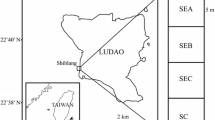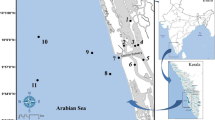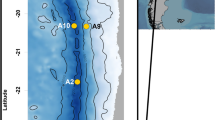Abstract
Intertidal zonation and seasonality of tropical meiobenthic communities were examined within five mangrove estuaries along the northeastern coast (Cape York peninsula) of Australia from May 1985 to January 1986. Partial correlation analysis revealed that environmental cues such as temperature and sediment granulometry were the most important factors regulating the zonation patterns of meiofauna. Seasonality was greatly influenced by monsoonal rains. During austral summer, prolonged monsoonal rains occurred along the coast north of 18°S latitude (Hinchinbrook Island), resulting in increased river discharge and scouring of surface silts and clays, organic matter and bacteria from most tidal sediments. Despite scouring, meiofaunal densities increased in the summer wet season, probably due to warmer temperatures and the high resilience of meiobenthos to sediment disturbance. In mangrove sediments not subjected to torrential rains (Hinchinbrook Island), meiofaunal densities were highest in austral autumn and winter (sediment temperature: 23 to 27°C) and lowest in austral spring and summer (28° to 40°C). Turbellarians were the dominant meiofaunal group, accounting for 58 to 67% of total faunal densities which generally decreased with elevation in all of the estuaries. Meiofauna in tropical Australian mangroves, as in other organic-rich muds and in coral reefs, appear to exert little impact on microbial standing stocks when intercorrelated variables are accounted for. The abundances of hard-bodied meiofauna were low compared with temperate communities, lending further support to Moore's (1972) contention that tropical intertidal communities are subjected to greater physical stress than their temperate counterparts.
Similar content being viewed by others
Literature cited
Admiraal, W., L. A. Bouwman, L. Hoekstra and K. Romeyn: Qualitative and quantitative interactions between microphytobenthos and herbivorous meiofauna on a brackish intertidal mudflat. Int. Revue ges. Hydrobiol. 68, 175–191 (1983)
Alongi, D. M.: Effect of physical disturbance on population dynamics and trophic interactions among microbes and meiofauna. J. mar. Res. 43, 351–364 (1985)
Alongi, D. M.: Quantitative estimates of benthic Protozoa in tropical marine systems using silica gel: a comparison of methods. Estuar., cstl Shelf Sci. 23, 443–450 (1986a)
Alongi, D. M.: Population structure and trophic composition of the free-living nematodes inhabiting carbonate sands of Davies Reef, Great Barrier Reef. Aust. J. mar. Freshwat. Res. 37, 609–619 (1986b)
Alongi, D. M.: Bacterial productivity and microbial biomass in tropical mangrove sediments. Microb. Ecol. 14, (In press) (1987)
Alongi, D. M., D. F. Boesch and R. J. Diaz: Colonization of meiobenthos in oil-contaminated sands of the lower Chesapeake Bay. Mar. Biol. 72, 325–335 (1983)
Boto, K. G., J. S. Bunt and J. T. Wellington: Variations in mangrove forest productivity in Northern Australia and Papua New Guinea. Estuar., cstl Shelf Sci. 19, 321–329 (1984)
Boto, K. G. and J. T. Wellington: Soil characteristics and nutrient status in a Northern Australian mangrove forest. Estuaries 7, 61–69 (1984)
Bunt, J. S.: Studies of mangrove litter fall in tropical Australia. In: Mangrove ecosystems in Australia, pp 223–237. Ed. by B. F. Clough. Canberra: Australian National University Press 1982
Coull, B. C., Z. Zo, J. H. Tietjen and B. S. Williams: Meiofauna of the Southeastern United States continental shelf. Bull. mar. Sci. 32, 139–150 (1982)
Decraemer, W. and A. Coomans: Scientific report on the Belgian expedition to the Great Barrier Reef in 1967. Nematodes. 13. A description of four known species from in and around mangroves on Lizard Island. Aust. J. mar. Freshwat. Res. 29, 509–541 (1978)
Dye, A. H.: Vertical and horizontal distribution of meiofauna in mangrove sediments in Transkei, Southern Africa. Estuar., cst Shelf Sci. 16, 591–598 (1983a)
Dye, A. H.: Composition and seasonal fluctuations of meiofauna in a southern African mangrove estuary. Mar. Biol. 73, 165–170 (1983b)
Eskin, R. A. and M. A. Palmer: Suspension of marine nematodes in a turbulent tidal creek: species patterns. Biol. Bull. mar. biol. Lab., Woods Hole 169, 615–623 (1985)
Folk, R. L.: Petrology of sedimentary rocks, 184 pp. Austin, Texas: Hemphill 1974
Ganapati, P. N. and G. C. Rao: Ecology of the interstitial fauna inhabiting the sandy beaches of Waltau coast. J. mar. biol. Ass. India 4, 44–57 (1962)
Gerlach, S. A.: Brasilianische Meeres-Nematoden. Bolm Inst. Oceanogr., S Paulo 5, 3–69 (1954)
Giere, O.: Population structure, food relations and ecological role of marine oligochaetes, with special reference to meiobenthic species. Mar. Biol. 31, 139–156 (1975)
Goodbody, I.: Mass mortality of a marine fauna following tropical rains. Ecology 42, 150–155 (1961)
Hansen, J. A., D. M. Alongi, D. J. W. Moriarty and P. C. Pollard: The dynamics of benthic microbial communities at Davies Reef, Central Great Barrier Reef. Coral Reefs 6 (In press) (1987)
Hobbie, J. E., R. J. Daley and S. Jasper: Use of Nuclepore filters for counting bacteria by fluorescence microscopy. Appl. envirl Microbiol. 33, 1225–1228 (1977)
Hodda, M. and W. L. Nicholas: Meiofauna associated with mangroves in the Hunter River Estuary and Fullerton Cove, Southeastern Australia. Aust. J. mar. Freshwat. Res. 36, 41–50 (1985)
Hopper, B. E., J. W. Fell and R. C. Cefalu: Effects of temperature on life cycles of nematodes associated with the mangrove (Rhizophora mangle) detrital system. Mar. Biol. 23, 293–296 (1973)
Krishnamurthy, K., M. A. Sultan Ali and M. J. P. Jeyseelan: Structure and dynamics of the aquatic food web community with special reference to nematodes in mangrove ecosystems. In: Proceedings of the Asian Symposium on Mangrove Environments: research and management, pp 429–452. Ed. by E. Saepadmo, A. N. Rao and O. J. MacIntosh. Kuala Lumpur: University of Malaysia Press 1984
Legendre, L., and P. Legendre: Numerical ecology, 487 pp. Amsterdam: Elsevier 1983
Lorenzen, C. J.: Determination of chlorophyll and phaeopigments: spectrophotometric equations. Limnol. Oceanogr. 12, 343–346 (1967)
Macnae, W.: A general account of the fauna and flora of mangrove swamps and forests in the Indo-West-Pacific region. Adv. mar. Biol. 6, 73–270 (1968)
Martens, P. M. and E. R. Schockaert: The importance of turbellarians in the marine meiobenthos: a review. Hydrobiologia 132, 295–303 (1986)
McIntyre, A. D.: The meiofauna and macrofauna of some tropical beaches. J. Zool., Lond. 156, 377–392 (1968)
McIntyre, A. D.: Control factors on meiofauna populations. Thalassia jugosl. 7, 209–215 (1971)
Milward, N. E.: Mangrove-dependent biota. In: Mangrove ecosystems in Australia, pp 121–139. Ed. by B. F. Clough. Canberra: Australian National University Press 1982
Montagna, P. A., B. C. Coull, T. L. Herring and B. W. Dudley: The relationship between abundances of meiofauna and their suspected microbial food (diatoms and bacteria). Estuar., cstl Shelf Sci. 17, 381–394 (1983)
Moore, H. B.: Aspects of stress in the tropical marine environment. Adv. mar. Biol. 10, 217–269 (1972)
Moriarty, D. J. W., P. C. Pollard, D. M. Alongi, C. R. Wilkinson and J. S. Gray: Bacterial productivity and trophic relationships with consumers on a coral reef. Proc. 5th. int. coral Reef Congr. 3, 457–462 (1985). (Ed. by C. Gabrie et al. Moorea, French Polynesia: Antenne Museum-EPHE)
Munro, A. L. S., J. B. J. Wells and A. D. McIntyre: Energy flow in the flora and meiofauna of sandy beaches. Proc. R. Soc. Edinb. (Sect. B) 76, 297–315 (1978)
Odum, W. E., and E. J. Heald: Trophic analyses of an estuarine mangrove community. Bull. mar. Sci. 22, 671–738 (1972)
Reise, K.: Tidal flat ecology, 211 pp. Berlin: Springer-Verlag 1985
Sokal, R. R. and F. J. Rohlf: Biometry. The principles and practice of statistics in biological research, 776 pp. San Francisco: W. H. Freeman & Co. 1969
Wells, F. E.: An analysis of marine invertebrate distributions in a mangrove swamp in Northwestern Australia. Bull. mar. Sci. 33, 736–744 (1983)
Wieser, W.: The meiofauna as a tool in the study of habitat heterogeneity: ecophysiological aspects. A review. Cah. Biol. mar. 16, 647–670 (1975)
Wood, L. W.: Chloroform-methanol extraction of chlorophyll a. Can. J. Fish. aquat. Sciences 42, 38–43 (1985)
Author information
Authors and Affiliations
Additional information
Communicated by G. F. Humphrey, Sydney
Rights and permissions
About this article
Cite this article
Alongi, D.M. Intertidal zonation and seasonality of meiobenthos in tropical mangrove estuaries. Mar. Biol. 95, 447–458 (1987). https://doi.org/10.1007/BF00409574
Accepted:
Issue Date:
DOI: https://doi.org/10.1007/BF00409574




